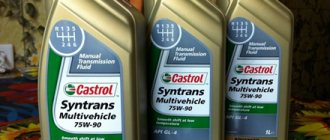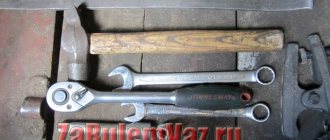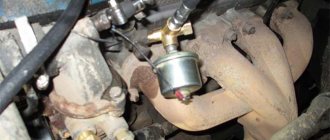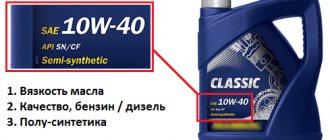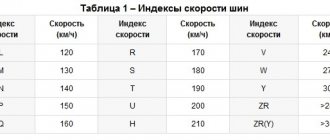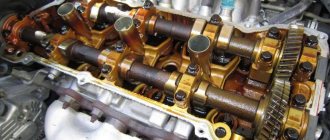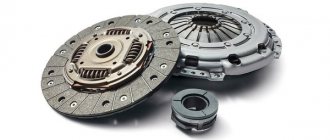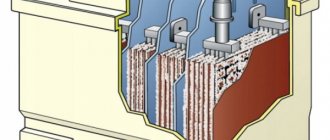Automotive manufacturing companies cannot do without the use of constant velocity joints. The proper functioning of these components determines the quality of functioning of a front-wheel drive vehicle. All mating parts that have a fairly high dynamic load are subject to high friction forces. Therefore, mandatory CV joint lubrication is required - these are plastic lithium compounds , which allow not only to maintain the hinges in good condition, but also to significantly extend their service life.
What is a CV joint, its functions and types?
CV joints are called constant velocity , which are used to ensure uninterrupted transmission of rotational motion from the gearbox and gearbox to the wheels at a constant speed. Their work occurs regardless of the angle of rotation, as well as the suspension or transmission. The design of these parts consists of external (fixed in the wheel hub) and internal (located in the transmission) hinges mounted on the axle shaft.
There are four types of CV joints:
- Ball CV joints are elements that transmit rotation using balls located in small grooves in body . They are mainly installed in front-wheel drive vehicles as an external wheel joint to provide high torque, as well as minimal play between the component elements. However, it must be taken into account that due to the special design of the ball CV joint, the axial movements of the suspension and transmission components are compensated not by it, but by other devices.
- Tripod elements are the most common type of CV joint that compensates for axial movements. A three-beam fork with rollers on needle bearings moving along guide grooves is fixed in the body of the structure. The tripod is used as internal wheel drive joints.
- Cam joints - these are usually installed in trucks. This is due to the fact that they have a low angular rotation speed, due to which the components are protected from overheating.
- Twin driveshafts are two connected joints used to compensate for uneven rotation of the balls. This type is installed in special equipment, as well as some models of trucks.
Regardless of the type of CV joint, the lubricant must be of good quality and changed in a timely manner. The appropriate product should be selected taking into account the type of components and technical characteristics of the vehicle in which they are used. Otherwise, used will be ineffective in reducing the friction force between parts.
Properties of lubricants for constant velocity joints
The composition of the CV joint lubricant is designed taking into account the difficult operating conditions of the joints, which makes it possible to provide reliable protection of the mechanism from the effects of various negative factors, as well as rapid wear. Due to their special properties, these products are used for the following purposes:
- increasing the friction coefficient of internal components;
- significant reduction in mechanical load on all components of the structure;
- slowing down the wear of individual hinge elements;
- increasing the protection of the surface of metal elements from corrosion destruction;
- ensuring a neutral reaction with different rubber hinge seals to protect the unit from damage;
- providing a water-repellent effect;
- extending the service life of the structure.
In this regard, a lubricant for external and internal hinges must have the following characteristics:
- Wide range of operating temperatures - from -40°C to +140°C and above, depending on the specific brand and article number . This property allows the composition to be used even in critical conditions without losing the effectiveness of protecting connections from loads.
- Increased degree of adhesion - the substance adheres well to the working surface of the device.
- High anti-scuff properties - due to this, an optimal level of sliding of the working surfaces is maintained.
- Physico-chemical, as well as mechanical stability of the product - these properties provide the same characteristics of the composition, regardless of the conditions of use.
To ensure safe and efficient operation of vehicles, CV joint lubricant must fully comply with the above requirements in terms of characteristics.
Main characteristics of the lubricant composition
Since it is important for many motorists that the lubricant performs all its stated functions, manufacturers are trying to develop formulations whose characteristics allow this to be done. If you try to list the parameters that such products have, you will get the following list:
- wide range of temperatures during use - up to 100 degrees Celsius, and sometimes more;
- ensuring strong adhesion to the surface, in other words, the lubricant is very sticky;
- excellent anti-scuff properties. The composition ensures normal sliding of the part over a long period;
- stability in mechanical, physical and chemical terms. It is extremely important for manufacturers that the lubricant retains its properties regardless of the external environment and loads.
All these parameters characterize the mixtures as high-quality and highly functional compositions. The products have good technical characteristics. parameters due to its unique composition. It should be noted here that products from different brands may have different compositions. Some details about CV joint lubricants can be found in the video:
Types of lubricants for CV joints
Manufacturers offer several types of CV joint grease. They differ not only in composition, but also in other parameters - operating features, efficiency, shelf life.
There are several popular types of lubricant:
- lithium;
- barium;
- products with molybdenum;
- on a polyurea basis.
The properties of these funds are discussed in detail below, the study of which will allow you to choose the most suitable option for a particular case.
Lithium CV joint greases
CV joint greases, which are made on the basis of lithium soap and thickeners, have a shade from pale yellow to light brown. It is better to lubricate CV joints with them, which will be operated at medium or high temperatures, because in other cases the substance quickly loses viscosity and does not provide adequate protection of the ball structure in cars with front-wheel drive .
CV joint grease with molybdenum
Molybdenum grease for CV joints is practically no different in properties from lithium products. However, due to the addition of molybdenum disulfide to the composition, the substance provides reliable anti-corrosion protection of metal surfaces.
When using this composition, it must be taken into account that if even a small amount of liquid gets on the boot, the joint lubricant quickly turns into an abrasive . Because of this, damage appears on the inner surface of the constant velocity joints. To avoid problems, it is necessary to regularly check the tightness of the case, as well as the condition of the anthers.
Barium lubricants
Barium grease is the most technologically advanced and effective method of maintaining CV joints in good condition. Such products have increased chemical resistance, as well as improved performance properties. In addition, these substances do not interact with moisture and polymers, therefore they are suitable for both internal and external CV joints. However, they should not be used at low temperatures, so as not to lose their quality.
Polyurea-based CV joint lubricant
Recently, polyurea-based products have often been chosen to lubricate pomegranates. They contain a synthetic polyurea ashless thickener. They are more plastic and differ significantly from traditional soap thickener substances.
There are several characteristic features:
- Excellent anti-oxidation properties prevent aging of the lubricant when operating at sufficiently high or low temperatures. Therefore, it is often used as a lifelong lubrication of constant velocity joints.
- The substance does not coke at a significant increase in the temperature of the working environment. In addition, no ash deposits are formed during operation, so no special maintenance of the structure is required.
- MS CV joint lubricant, thickened with polyurea, is characterized by increased water resistance - this property allows the device to be operated not only at high humidity, but also under conditions of dynamic exposure to liquid.
- Increased resistance to chemically active environments (alkali or acid).
Which lubricant for CV joints is better at low temperatures?
CV joint lubrication must work in different conditions, including temperatures down to -50°C. The most suitable brands for use in the cold season are the CV joints MS X5, CV joints-4, RAVENOL Mehrzweckfett mit MoS-2.
What lubricants should not be used for CV joints?
For lubrication, you cannot use any CV joint or lithol. It is necessary to familiarize yourself with the composition and determine whether the product will work under certain conditions. In particular, it is prohibited to lubricate CV joints with the following substances:
- graphite lubricant;
- "Grease 158";
- technical petroleum jelly;
- oils containing hydrocarbon compounds;
- substances containing calcium or sodium;
- various compositions based on zinc or iron.
Graphite lubricant, like the other listed substances, not only does not provide adequate protection of the boot and other elements from wear, but also reduces the quality of the vehicle.
Domestic manufacturers
In Northern Palmyra, production of an assortment of VMPAVTO lubricants has begun. A new product called “MS-CV joint tripod”. The instructions for use state that the lubricant is recommended for universal use at temperatures up to +160 C°. Other positive information is also given. Little has been said about the shortcomings.
Manufacturers of the VMPAVTO lubricant “forgot” to describe in detail the technical characteristics of the product. It seems that the buyer must take the seller's word for it. To some extent, the mistake of a branded enterprise is not clear to customers.
The product sold does not mention whether the lubricant has been tested. What side inclusions are integrated into the consistency? The lack of basic product descriptions cannot but alarm buyers. They want to know almost everything about the domestic VMPavto product.
Reviews VMPAUTO
Specialized forums on the Internet will help you understand this issue. The information that has appeared about the release of a new domestic lubricant product with good consumer characteristics has been positively received by many forum participants. A large number of supporters of the product confirm in the comments that the VMPAUTO product for CV joints meets Russian standards. The quality is confirmed by certificates and documents of conformity.
There are flattering reviews about the containers used. Synthetic dishes are practical to use, safe, and equipped with the necessary information base. And, of course, a reasonable price. Imported analogues are much more expensive. Domestic products are bought in all regions of the country. Every day the interest of motorists in it increases.
Replacing lubricant in CV joints
Changing the CV joint grease is quite simple, so you can do the job yourself. To do this, follow the step-by-step instructions:
- First, you need to remove the CV joint - the sequence of removing the device depends on the design features of the vehicle, so there is no single algorithm of actions.
- Disassembling joint tube - you need to carefully remove the two retaining rings using a screwdriver.
- Dismantling the boot and sealing ring, as well as checking them for various damages - if any are found, they should be replaced.
- Removing all internal parts and then disassembling.
- Washing the elements in gasoline or solvent - carefully remove any remaining old lubricant.
- About 90 g of lubricant is placed in the glass - to fill the substance into the container gradually.
- Installing the tripod in its original place.
- At the end, you need to add the missing amount of lubricant to the CV joint - you will need approximately 120-150 g of the substance. To fill the glass tightly, you need to gradually move the tripod axis in the process.
- The assembly of the structure is carried out in the reverse order to dismantling. In this case, it is necessary to check that the axis of symmetry of the separator should be perpendicular to the body. Finally, you need to lubricate the grooves and then tighten all the clamps or rings tightly.
All components must be well lubricated, so the amount of substance must be calculated correctly.
How often do you change the lubricant?
The lubricant for the grenade should be changed every 80-100 thousand km. However, it must be taken into account that if the vehicle is used in rather harsh conditions, it is better to replace it after a run of 50-60 thousand km.
Properly lubricate the tripod joint
Despite the fact that the design of the tripoid hinge is based on the use of needle bearings, lubricating them with 158 grease, which is usually used for needle bearings, is strictly prohibited. The fact is that a lithium thickener is used for its manufacture, and it can work at a temperature no higher than 120 ○C, and the temperature of the internal grenade reaches 160 ○C. Since the lubricant for the internal grenade is quite liquid, it is better to pour it inside the boot installed on the drive, and then assemble the tripoid. You need to fill in from 100 to 130 g of lubricant. More precisely, to the question, “how much?” the manufacturer will answer.
Share with friends on social networks:
Telegram
Application of lubricants for CV joints
To use lubricant for ball CV joints, it is necessary to select a product of a suitable brand, based on the type and characteristics of the component elements.
Suitable for lubrication of the inner CV joint:
- Slipkote Polyurea CV Joint Grease;
- Mobil SHC Polyrex 005;
- VAG G052186A3;
- Mobile Mobilegris XHP 222;
- BP Energrease LS-EP2.
Any of these products can be applied without removing parts from the structure.
For external lubrication in CV joints, the following brands can be used:
- Mobil Mobilgrease special NLGI 2;
- Liqui Moly LM 47 Langzeitfett + MoS2;
- Chevron SRI Grease NLGI 2;
- XADO CV joint;
- lubricant "CV joint-4".
The best lubricant for CV joints
When purchasing this product, you can be guided reviews , recommendations from equipment service specialists and vehicle manufacturers.
The rating of CV joint lubricants includes five popular products:
- CV joints-4 are Russian-made products that are used to lubricate ball bearings of external joints, parts in telescopic struts, and carburetors. It is made on the basis of lithium hydroxystearate and is suitable for use at temperatures from -40°C to +120°C.
- SHRUS-MS VMPAUTO lubricant is a black Vaseline-like composition of domestic production, which in terms of consistency belongs to class ⅔ according to the NLGI system. Its penetration range is 265-295 for class 2 and 220-250 for class 3. The substance is typically used to treat bearings to reduce friction within them. It should be noted that its consistency is maintained even after the anther is damaged.
- Liqui Moly LM 47 Langzeitfett + MoS2 is a German lubricant that is made in the form of a plastic liquid with a fairly thick consistency. This substance has a dark, almost black color. A lithium complex is used as a thickener, in addition to which the composition contains various additives, mineral base oil, as well as solid particles to reduce the friction force between elements. This product is excellent for servicing external CV joints, which are operated at temperatures from -30°C to +125°C.
- RAVENOL Mehrzweckfett mit MoS-2 is a substance that is produced in Germany with the addition of molybdenum disulfide. It is resistant to salt water, and also perfectly retains its performance properties over a wide temperature range - from 30°C to +120°C.
- XADO for CV joints is a Ukrainian lubricant from the budget category, which is intended for processing external joints. It has a light amber tint and contains a special revitalizant that slows down deformation and wear of component parts.
- STEP UP is an American lithium grease that can be used for internal and external CV joints. This is a high-temperature substance that operates at temperatures up to +250°C. Its distinctive feature is the presence of a lithium complex, a special conditioner SMT2, and molybdenum disulfide.
lubricated with a high-quality composition are a mandatory requirement for vehicle operation, especially in aggressive conditions. When choosing a lubricant, it is necessary to take into account the design features of constant velocity joints, as well as the conditions of use of the vehicle. You can choose a suitable product and perform the replacement yourself or with the help of a specialist.

